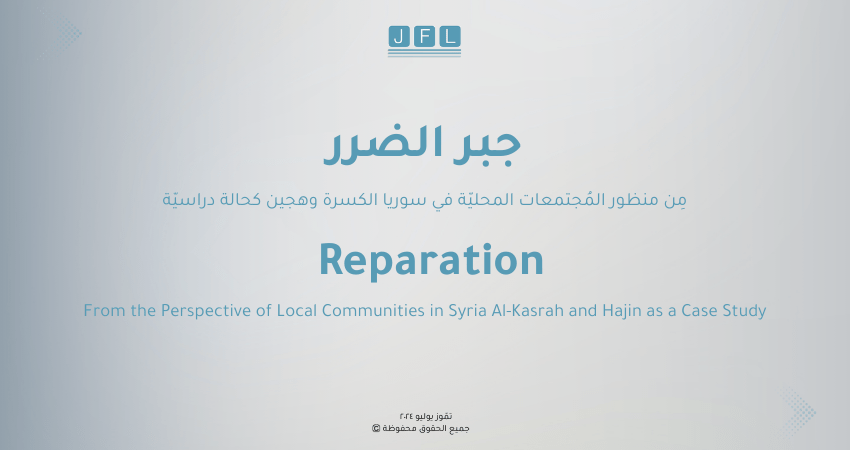This research paper presents an analysis of the perceptions of representatives[1] from local communities in Al-Kasrah and Hajin areas of Deir ez-Zor[2] regarding measures of reparation that could address the harm suffered by individuals and communities in these areas due to patterns of violations witnessed during years of conflict. The paper aims to present these opinions and perceptions as a case study analysed through a participatory approach to understand how local communities view the feasibility and potential implementation of reparation measures. Additionally, it discusses the criteria and elements that should be considered at all stages of addressing this issue, based on an understanding of the unique experiences of these communities during the conflict, as well as their cultural and social environment.
By comparing the perspectives of the participants in this paper with relevant standards and principles in the provisions and interpretations of international law and transitional justice, in addition to the opinions of experts and practitioners in these fields, this research paper concludes with a set of findings aimed at contributing to a broader objective discussion on reparations in Syria. The key findings can be summarized as follows:
- Discussing reparation measures, despite the ongoing conflict and the lack of readiness of other transitional justice elements, does not imply dispensing with these measures or imposing priorities contrary to the interest or general orientations. Contemplating reparation enhances awareness and reaffirms the victims’ and local communities’ commitment to their inherent rights to effective remedy, emphasizing the legal duties of conflict parties, foremost among them the Syrian State.
- Transitional justice programs must be officially designed and implemented at the national level when the necessary conditions are met, foremost among them achieving transition and establishing a framework that ensures the legal certainty of these programs and the entitlements they provide. Engaging with local communities in open dialogues and informed consultations about reparation measures and/or other elements of transitional justice constitutes a form of victim and community participation, ensuring the preparation of the form and content of transitional justice programs.
- “Harm reduction” interventions may play a crucial role in mitigating the intensity of conflict and encouraging victims to take initiative in active participation in public life and expanding access to the victim community, even in the current situation and despite the ongoing conflict.
- The comprehensive and inclusive approach to transitional justice does not contradict the design of interventions based on a “customized” approach that target specific local communities and consider and respond to the specificities of their experiences, cultural, and social environments. This approach contributes to overcoming many challenges facing the design and implementation of reparation measures, such as establishing victim registries and identifying patterns of violations and appropriate reparative measures to address their effects.
- The broad and multi-level scope of patterns of violations has led to a convergence between individual and collective harm in local communities. This necessitates the design of reparation programs that take this impact into account, while at the same time not conflicting with individual rights to reparation. Efforts contributing to “harm mitigation” or sometimes referred to as “interim reparative measures”[3] should not pose legal dilemmas in the future, such as claiming that individuals who have benefited from certain entitlements for harm mitigation have waived their right to reparations and absolved the authority responsible for implementing transitional justice programs from that responsibility.
- The traditional community measures and structures may positively contribute to the design and implementation of reparation measures tailored to local communities due to their stability and societal acceptance. However, this role should not be isolated from multiple considerations to ensure it does not lead to further conflicts or undermine the rule of law and human rights of individuals and communities.
- Rehabilitation is considered one of the most important measures that provides essential entitlements for both individual and collective reparations, intersecting with other measures and contributing to their success, such as those related to economic and livelihood situations, restitution, compensation, and commemoration. Financial compensation measures specifically should be handled sensitively, taking into account the prevailing cultural and social backgrounds in each local community, ensuring they do not create a competitive environment that detracts from the primary goals of reparation.
- Reparation measures derive their legitimacy from the active participation of victims and local communities in their design, implementation, and monitoring. This participation should not be merely symbolic or limited to general consultation; rather, it should meet a fundamental precondition of informed knowledge sharing. Supporting victim groups and family networks is an effective strategy to facilitate their active participation by enhancing their access, communication, and sharing of informed knowledge, as well as discussing reparation priorities through simplified and accepted means based on solidarity and shared experiences.
- Despite the commonalities between humanitarian, development, and early recovery efforts on one hand, and reparations measures on the other, the role of the entities involved in these interventions must be distinct and based on a rights-based approach rather than merely responding to needs.
- Civil society organizations (CSOs) play a primary role in discussing and designing reparation measures at any stage, with the necessity for their interventions to be based on expertise and a participatory approach with local communities.
Read more: Reparation













